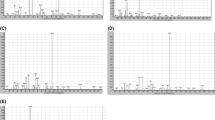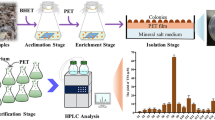Abstract
The main objective of the present study was to isolate polyhydroxyalkanoate-producing pseudomonads from the petroleum hydrocarbon-contaminated area, investigate bioremediation potential of these bacteria and then optimize the culture conditions for maximum bacterial growth and polyhydroxyalkanoate production from crude oil. Forty-five oil-degrading pseudomonads were isolated and 15 polyhydroxyalkanoate-producing pseudomonads have been detected. Temperature = 30 °C, incubation time = 7 days, polyhydroxyalkanoates production media and 2% (V/V) crude oil were selected as the optimum conditions for maximum bacterial growth and polyhydroxyalkanoates accumulation. Finally, the produced biopolymers were characterized by gas chromatography/mass spectrometry. Under the optimal conditions, the highest bacterial growth (optical density 600 nm) and polyhydroxyalkanoates content (% W/W) were 0.35 ± 0.05 and 22.25 ± 0.13, respectively. The present study shows that unfavorable conditions such as petroleum-contaminated area can be potential resources for polyhydroxyalkanoates producers. These isolates could be used in future bioremediation of hydrocarbons while producing industrially relevant polymers as a by-product at the optimal condition.




Similar content being viewed by others
References
Anderson AJ, Dawes EA (1990) Occurrence, metabolism, metabolic role, and industrial uses of bacterial polyhydroxyalkanoates. Microbiol Rev 54:450–472
Atlas RM (1981) Microbial-degradation of petroleum-hydrocarbons—an environmental perspective. Microbiol Rev 45:180–209
Atlas RM (1995) Petroleum biodegradation and oil spill bioremediation. Mar Pollut Bull 31:178–182. https://doi.org/10.1016/0025-326x(95)00113-2
Banat IM (1995) Biosurfactants production and possible uses in microbial enhanced oil-recovery and oil pollution remediation—a review. Bioresour Technol 51:1–12. https://doi.org/10.1016/0960-8524(94)00101-6
Breed RS, Murray EGD, Smith NR (1975) Bergey’s manuel determinative bacteriology. The Williams & Wilkins Co., Baltimore
Burdon KL (1946) Fatty material in bacteria and fungi revealed by staining dried, fixed slide preparations. J Bacteriol 52:665–678
Chanprateep S (2010) Current trends in biodegradable polyhydroxyalkanoates. J Biosci Bioeng 110:621–632
Dalal J, Sarma PM, Lavania M, Mandal AK, Lal B (2010) Evaluation of bacterial strains isolated from oil-contaminated soil for production of polyhydroxyalkanoic acids (PHA). Pedobiologia 54:25–30. https://doi.org/10.1016/j.pedobi.2010.08.004
Davis R et al (2013) Conversion of grass biomass into fermentable sugars and its utilization for medium chain length polyhydroxyalkanoate (mcl-PHA) production by Pseudomonas strains. Bioresour Technol 150:202–209
Ebadi A, Olamaee M, Khoshkholgh Sima NA, Ghorbani Nasrabadi R, Hashemi M (2017) Isolation and characterization of biosurfactant producing and crude oil degrading bacteria from oil contaminated soils. Iran J Sci Technol Trans Sci. https://doi.org/10.1007/s40995-017-0162-8
Eggink G, de Waard P, Huijberts GNM (1992) The role of fatty acid biosynthesis and degradation in the supply of substrates for poly(3-hydroxyalkanoate) formation in Pseudomonas putida. FEMS Microbiol Lett 103:159–163. https://doi.org/10.1016/0378-1097(92)90305-8
Fernandez D et al (2005) Agro-industrial oily wastes as substrates for PHA production by the new strain Pseudomonas aeruginosa NCIB 40045: effect of culture conditions. Biochem Eng J 26:159–167. https://doi.org/10.1016/j.bej.2005.04.022
Franzetti L, Scarpellini M (2007) Characterisation of Pseudomonas spp. isolated from foods. Ann Microbiol 57:39–47
Goh YS, Tan IKP (2012) Polyhydroxyalkanoate production by antarctic soil bacteria isolated from Casey Station and Signy Island. Microbiol Res 167:211–219. https://doi.org/10.1016/j.micres.2011.08.002
Goudarztalejerdi A, Tabatabaei M, Eskandari MH, Mowla D, Iraji A (2015) Evaluation of bioremediation potential and biopolymer production of pseudomonads isolated from petroleum hydrocarbon-contaminated areas. Int J Environ Sci Technol 12:2801–2808. https://doi.org/10.1007/s13762-015-0779-0
Hang XM, Lin ZX, Chen JY, Wang GL, Hong K, Chen GQ (2002) Polyhydroxyalkanoate biosynthesis in Pseudomonas pseudoalcaligenes YS1. FEMS Microbiol Lett 212:71–75. https://doi.org/10.1111/J.1574-6968.2002.Tb11247.X->
Hassanshahian M, Emtiazi G, Cappello S (2012) Isolation and characterization of crude-oil-degrading bacteria from the Persian Gulf and the Caspian Sea. Mar Pollut Bull 64:7–12
He WN, Tian WD, Zhang G, Chen GQ, Zhang ZM (1998) Production of novel polyhydroxyalkanoates by Pseudomonas stutzeri 1317 from glucose and soybean oil. FEMS Microbiol Lett 169:45–49. https://doi.org/10.1111/j.1574-6968.1998.tb13297.x
Hooks DO, Blatchford PA, Rehm BHA (2013) Bioengineering of bacterial polymer inclusions catalyzing the synthesis of N-acetylneuraminic acid. Appl Environ Microbiol 79:3116–3121. https://doi.org/10.1128/Aem.03947-12
Lageveen RG, Huisman GW, Preusting H, Ketelaar P, Eggink G, Witholt B (1988) Formation of polyesters by Pseudomonas oleovorans—effect of substrates on formation and composition of poly-(R)-3-hydroxyalkanoates and poly-(R)-3-hydroxyalkenoates. Appl Environ Microbiol 54:2924–2932
Lee EY, Choi CY (1997) Structural identification of polyhydroxyalkanoic acid (PHA) containing 4-hydroxyalkanoic acids by gas chromatography mass spectrometry (GC-MS) and its application to bacteria screening. Biotechnol Tech 11:167–171
Liu CL, Wang HB, Xing WH, Wei L (2013) Composition diversity and nutrition conditions for accumulation of polyhydroxyalkanoate (PHA) in a bacterial community from activated sludge. Appl Microbiol Biotechnol 97:9377–9387
Luengo JM, García B, Sandoval A, Naharro G, Olivera ER (2003) Bioplastics from microorganisms. Curr Opin Microbiol 6:251–260. https://doi.org/10.1016/S1369-5274(03)00040-7
Mokhtari-Hosseini ZB, Vasheghani-Farahani E, Heidarzadeh-Vazifekhoran A, Shojaosadati SA, Karimzadeh R, Darani KK (2009) Statistical media optimization for growth and PHB production from methanol by a methylotrophic bacterium. Bioresour Technol 100:2436–2443. https://doi.org/10.1016/j.biortech.2008.11.024
Nwinyi OC, Amund OO (2017) Biodegradation of selected polycyclic aromatic hydrocarbons by axenic bacterial species belonging to the genera Lysinibacillus and Paenibacillus. Iran J Sci Technol Trans Sci 41:577–587. https://doi.org/10.1007/s40995-017-0291-0
Olivera NL, Esteves JL, Commendatore MG (1997) Alkane biodegradation by a microbial community from contaminated sediments in Patagonia, Argentina. Int Biodeterior Biodegrad 40:75–79. https://doi.org/10.1016/S0964-8305(97)00065-6
Parlane NA, Rehm BHA, Wedlock DN, Buddle BM (2014) Novel particulate vaccines utilizing polyester nanoparticles (bio-beads) for protection against Mycobacterium bovis infection—a review. Vet Immunol Immunopathol 158:8–13
Pham TH, Webb JS, Rehm BH (2004) The role of polyhydroxyalkanoate biosynthesis by Pseudomonas aeruginosa in rhamnolipid and alginate production as well as stress tolerance and biofilm formation. Microbiology 150:3405–3413. https://doi.org/10.1099/mic.0.27357-0
Rahman KSM, Thahira-Rahman J, Lakshmanaperumalsamy P, Banat IM (2002) Towards efficient crude oil degradation by a mixed bacterial consortium. Bioresour Technol 85:257–261
Rambeloarisoa E, Rontani JF, Giusti G, Duvnjak Z, Bertrand JC (1984) Degradation of crude-oil by a mixed population of bacteria isolated from sea-surface foams. Mar Biol 83:69–81. https://doi.org/10.1007/Bf00393087
Reddy SV, Thirumala M, Reddy TVK, Mahmood SK (2008) Isolation of bacteria producing polyhydroxyalkanoates (PHA) from municipal sewage sludge. World J Microbiol Biotechnol 24:2949–2955. https://doi.org/10.1007/s11274-008-9839-7
Rehm BHA (2010) Bacterial polymers: biosynthesis, modifications and applications. Nat Rev Microbiol 8:578–592. https://doi.org/10.1038/Nrmicro2354
Rehm BHA, Steinbuchel A (1999) Biochemical and genetic analysis of PHA synthases and other proteins required for PHA synthesis. Int J Biol Macromol 25:3–19. https://doi.org/10.1016/S0141-8130(99)00010-0
Sood N, Lal B (2009) Isolation of a novel yeast strain Candida digboiensis TERI ASN6 capable of degrading petroleum hydrocarbons in acidic conditions. J Environ Manag 90:1728–1736
Spiekermann P, Rehm BHA, Kalscheuer R, Baumeister D, Steinbuchel A (1999) A sensitive, viable-colony staining method using Nile red for direct screening of bacteria that accumulate polyhydroxyalkanoic acids and other lipid storage compounds. Arch Microbiol 171:73–80. https://doi.org/10.1007/s002030050681
Spilker T, Coenye T, Vandamme P, LiPuma JJ (2004) PCR-based assay for differentiation of Pseudomonas aeruginosa from other Pseudomonas species recovered from cystic fibrosis patients. J Clin Microbiol 42:2074–2079
Steinbuchel A, Fuchtenbusch B (1998) Bacterial and other biological systems for polyester production. Trends Biotechnol 16:419–427
Stoffels M, Amann R, Ludwig W, Hekmat D, Schleifer KH (1998) Bacterial community dynamics during start-up of a trickle-bed bioreactor degrading aromatic compounds. Appl Environ Microbiol 64:930–939
Varjani SJ (2017) Microbial degradation of petroleum hydrocarbons. Bioresour Technol 223:277–286. https://doi.org/10.1016/j.biortech.2016.10.037
Varjani SJ, Upasani VN (2016) Biodegradation of petroleum hydrocarbons by oleophilic strain of Pseudomonas aeruginosa NCIM 5514. Bioresour Technol 222:195–201. https://doi.org/10.1016/j.biortech.2016.10.006
Westlake DW, Jobson A, Phillipp R, Cook FD (1974) Biodegradability and crude-oil composition. Can J Microbiol 20:915–928
Zinn M, Witholt B, Egli T (2001) Occurrence, synthesis and medical application of bacterial polyhydroxyalkanoate. Adv Drug Deliv Rev 53:5–21
Acknowledgements
The authors are grateful to Professor Bernd H. A. Rehm (Professor of Microbiology, Massey University, New-Zealand) for his guidance and Mr. Amin Shahed for excellent technical assistance.
Funding
This work was supported by a Grant (891941) from the Shiraz University.
Author information
Authors and Affiliations
Contributions
AG and MHE conceived the project. MT, MHE and DM supervised the study. AG performed experiments. AG and MHE wrote the manuscript. All authors reviewed the manuscript.
Corresponding author
Ethics declarations
Conflict of interest
On behalf of all authors, the corresponding author states that there is no conflict of interest.
Rights and permissions
About this article
Cite this article
Goudarztalejerdi, A., Tabatabaei, M., Eskandari, M.H. et al. Optimization Conditions for Maximum Oil Bioremediation and Biopolymer Production by Pseudomonads. Iran J Sci Technol Trans Sci 43, 1439–1446 (2019). https://doi.org/10.1007/s40995-018-0652-3
Received:
Accepted:
Published:
Issue Date:
DOI: https://doi.org/10.1007/s40995-018-0652-3




